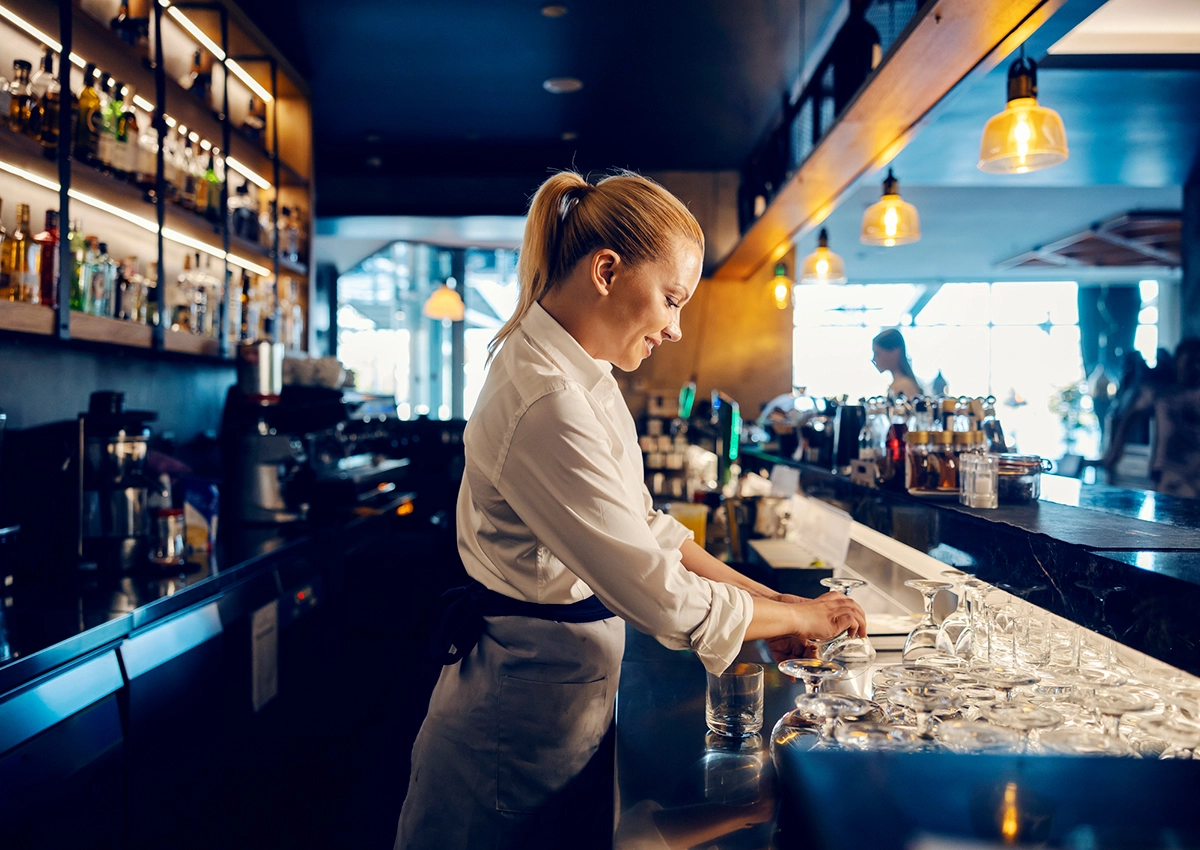Are you keeping a close eye on your beer, wine, & liquor inventory costs? Operators who calculate their cost of sales add 2–10% to their bottom line. Meanwhile, a restaurant’s bar program represents a significant source of total revenue. It also has one of the most complex stock lists.
Because liquor, wine, and beer have such wildly varying prices, it pays to keep tight controls on ordering and inventory. Loss, waste, inconsistency — without careful management of bar inventory, you’re quickly losing a decent chunk of money. Those losses are avoidable with bar inventory management systems, whether home-brewed or automated through software.
What is a bar inventory management system?
A bar inventory management system enables restaurants to closely monitor stock levels and usage of all liquor, beer, wine, mixers, and other beverage products behind the bar. These tools broadly perform the following steps:
- Establish inventory on hand
- Reconcile deliveries received
- Track ongoing usage through daily or real-time orders
- Calculate loss and waste through expected vs. actual inventory
Why bar inventory matters
Let’s start by getting clear on what exactly careful inventory management accomplishes.
You may be wasting 10% of product
We may be talking about bar inventory here, but food waste trends bear mentioning. Studies have found that restaurants waste 4–10% of food purchased, and diners leave as much as 17% of portions uneaten. Take these lessons to heart. Monitor your portion sizes (and pour sizes). If they’re too large, bar inventory and staff coaching can track and correct these issues while reducing overall orders in the process.
Curb 75% of shrinkage
One of the biggest revenue drains on bar inventories comes from pouring inconsistencies, slip ups ringing in drinks, and good old-fashioned pilfering. Even trusted bartenders fall subject to free-pour variation, especially during crowded shifts. Regularly tracking your bar inventory helps quickly catch common culprits and course correct, whether that means adjusting a recipe or training staff.
Informed purchasing decisions
Eliminating guesswork around usage and depletion enables smarter restocking aligned with demand. Historical data illustrates bestselling items so you replenish accordingly rather than overloading on products accumulating dust on your shelves.
Consistent quality
Perpetual stockouts due to inaccurate tracking? Think again! Reliable inventory counts let you prep all ingredients necessary for crafting drinks to menu spec every time. Out of maraschino cherries? Low on limes? Now you catch that before service takes a hit.
Expiration prevention
First in, first out isn’t just best practice advice. When enforced systematically, FIFO rotation eliminates wastage from perishables expiring before use. Ongoing visibility into expiration dates across remaining product keeps the team diligent.
Accountability across the board
Comprehensive inventory management extends beyond limiting bartenders’ pilfering temptation. Detailed reporting produces transparency around product usage compared to sales metrics. Use it to identify sources of ongoing waste whether it stems from prep mishaps, server errors, or even menu mismatch. Take a moment to pinpoint problem areas and then coach staff accordingly.
All these benefits hinge on setting up an efficient, automated tracking process. Don’t despair — it’s very attainable with help from the right tools.
Getting started with bar inventory management
Follow these steps to start the process of bar inventory management.
- Establish product pars (min/max levels) based on historical data, if available. This aids with creating reordering triggers when stock dips.
- Standardize recipe builds and pour amounts for all cocktails and drafts. Precise amounts tied to sales data improves usage analysis.
- Outline procedures for delivery logs, counting, waste tracking and reconciling variances. Uniform processes reduce errors.
- Take stock on a regular schedule and compare it against your expected stock.
- Correct any irregularities you encounter.
Bar inventory management takes time and careful planning, but it’s worth it. Once you get started, it gets easier every time. The great news about this powerful process is that you can automate it. Integrating inventory with your bar POS system enables efficient tracking at volume. So as your business grows, your revenue will keep pace. We’ll discuss how automation pays for itself in the next section.
Getting on top of your bar inventory: Best practices for control and efficiency
Incorporate these principles to quickly zero in on the biggest revenue drivers (and hits) in your bar program. The most cost-effective shortcut to implementing many of these is to use an integration like CAKE’s Orca integration to sync your POS to inventory management. These best practices illustrate why — some of them can be done with some diligence and a spreadsheet. Others require POS systems like CAKE + Orca to truly make increasing bar revenue effortless.
Integrate your recipes
Standardize and document each drink recipe in your ordering terminal. These recipes and portions will then automatically factor into stock calculations so you’ll know in advance when essential ingredients are running low. As bartenders pour from designated bottles, inventory deducts in real time.
Track usage
Granular data reports illuminate red flag behaviors like over-pouring or questionable voids after the fact. Compare bar inventory to sales metrics to identify (and coach!) chronic offenders.
Create low stock warnings
Prevent stockouts that put popular drinks 86’d for the night. Configurable par levels trigger alerts at ideal replenishment thresholds specific to each product. Place reorders or assign shopping lists before you fully run dry.
Print labels for easy stock management
Humans make mistakes, but printed shelf labels leave zero room for bottles in the wrong place. Use a bar inventory management system to match your existing format or customize templates by supplier, price tier, recipe spec – whatever makes sense for your program.
Keep delivery logs
Verify incoming shipments accurately reflect your ordered quantities to rule out supplier shorting. Digital logs reconcile against pending purchase orders to catch discrepancies.
Each of these POS-integrated best practices can shave a chunk off of your bar inventory losses and put money in your pocket. But even the most advanced tech can’t work magic without smart foundational practices.
Common-sense approaches to bar inventory management
Taking charge of your liquor means grasping key concepts directly impacting its oversight. Don’t fret if terms like pour cost or pars cause lingering confusion. With a few fundamental steps, you’ll find inventory far more manageable than it first appeared.
Understand pour costs
Don’t gloss over this one even though the math might seem intimidating. Pour cost refers to the ratio of a bottle’s cost to the revenue generated from drinks made using that bottle. Generally a range around 20-25% pour cost is ideal to earn decent profit margins from liquor while keeping prices reasonable for patrons.
If you utilize POS-integrated recipes, pour costs get calculated automatically as bottles drain. This helps immensely in making pour cost control less abstract. Still, knowing the concept itself helps contextualize why tracking matters. It’s not just bureaucratic busywork!
Define par levels
Pars represent desired inventory thresholds that trigger proactive reordering. Think minimum and maximum levels per product based on historical demand and usage patterns. Defining pars by day or week provides STRONGER proactive replenishment guidance than sporadic refills from gut intuition. If you blow through a customer-favorite favorite beer in a week but a case of bitters typically takes a couple months, defining pars helps you make smart ordering decisions.
Standardize processes
Eliminate confusion by clearly documenting systemwide procedures around inventory tasks like deliveries, counting, transfers, waste logging etc. Identify designated owners and required tracking to uphold continuity even with shift changes. Uniform expectations and communication prevent surprises that send shipments crashing into the weeds.
Take regular stock. Manually.
Real-time bar inventory management will transform your life. However, you should still perform full physical inventories regularly to verify calculated amounts match actuals on hand. Depending on the size of your lineup, schedule your counts by section monthly or quarterly. If you spot unexplained trends like more bottles depleted than sales justify, investigate to rule out underlying issues like staff overpouring before write offs balloon out of control.
Make inventory a breeze with CAKE
You work in a fast-paced industry packed with high-value products ripe for misuse. This offers some unique hurdles when it comes managing bar inventory. But by leveraging purpose-built tools like CAKE POS for bars alongside fundamental best practices, getting a handle on your liquor asset becomes very realistic.
CAKE comes off-the-shelf with tools that easily track and analyze order volume. Through direct integrations with inventory management software, CAKE supports all of the best practices we’ve discussed here, allowing pinpoint accuracy and decision making based on real revenue.
Read how San Francisco’s Japanese Tea Garden reduced errors and improved purchasing decisions with CAKE, all while reducing customer wait time and growing staff gratuities 50%.
“Because of the system, I can now see exactly how much tea I have sold.” “This makes reordering much easier for me than before when I had to manually add up numbers.”
—Tak Matsuba, Manager
Make proactive control your norm rather than reacting to stock emergencies way too late. Your budget will thank you!
Ready to tame the beast that is bar inventory? Let’s connect to explore how CAKE’s specialized features apply to your business specifically. Trust me – with smarter visibility and accountability, you’ll gain hours back rather than lose hair over another mystifying inventory variance. Sound like a win? Reach out and let’s talk options!







